

Poetry. Medieval Poems. Poems during the medieval era were religious in nature and written by clerics.
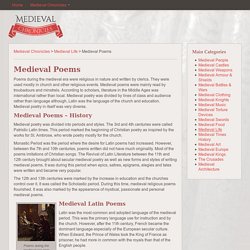
They were used mostly in church and other religious events. Medieval poems were mainly read by troubadours and minstrels. According to scholars, literature in the Middle Ages was international rather than local. Medieval Period. Medieval Literature (c. 350 – c. 1475) The Medieval period runs from the end of Late Antiquity in the fourth century to the English Renaissance of the late fifteenth century.
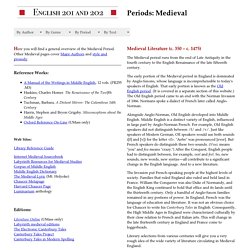
The early portion of the Medieval period in England is dominated by Anglo-Saxons, whose language is incomprehensible to today's speakers of English. That early portion is known as the Old English period. (It is covered in a separate section of this website.) The Old English period came to an end with the Norman Invasion of 1066. Alongside Anglo-Norman, Old English developed into Middle English. The Invasion put French-speaking people at the highest levels of society. Literary selections from various centuries will give you a very rough idea of the wide variety of literature circulating in Medieval England. 12th Century. Thomas Becket.
Thomas Becket, Archbishop of Canterbury, was killed in December 1170.
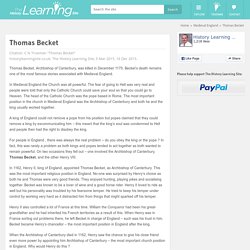
Becket’s death remains one of the most famous stories associated with Medieval England. In Medieval England the Church was all powerful. The fear of going to Hell was very real and people were told that only the Catholic Church could save your soul so that you could go to Heaven. History - Geoffrey Chaucer. The Norton Anthology of English Literature: The Middle Ages: Review: Summary. Middle Ages, Dynamic Culture of the Middle Ages. The European High Middle Ages, which lasted from about 1050 to 1300, evoke for many people romantic images of knights in shining armor, magnificent castles, and glorious cathedrals.
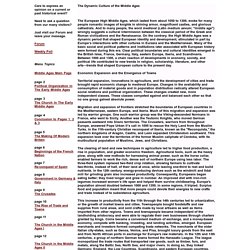
And to many people, the word medieval (Latin medium aevum; "middle age") wrongly suggests a cultural intermission between the classical period of the Greek and Roman civilizations and the Renaissance. Medieval Introduction. By about 1050, the invasions had run their course: the Moslems were in retreat; the Vikings and Hungarians had adopted Christianity and so became participants in western civilization.

In the tenth century, the three-field system of crop rotation became popular, horses (more efficient than oxen) and iron plows were used, all resulting in surplus food and a better standard of living (Rosenwein 93). By 1000 we've got metal shoes for the horses and oxen to increase their work-lives, tandem harnesses for pulling with the shoulders instead of the neck. Chivalry and Courtly Love. Code of Chivalry. More often than not, Chivalry was associated with knighthood.
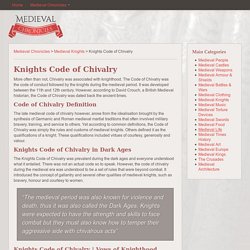
Code of Chivalry. Facts and interesting information about the life and times of the Medieval Knights of England - Code of Chivalry Code of Chivalry There was not an authentic Code of Chivalry as such.
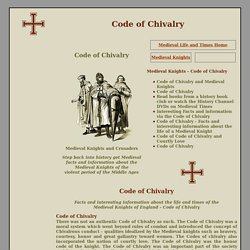
Medieval History, Castles. MedievalPlus.com The Middle Ages is a period in European history which, along with its adjective ‘Medieval’, was first referred to by italian scholars and academics of the late fifteenth century.
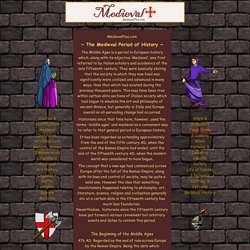
They were basically stating that the society in which they now lived was significantly more civilized and advanced in many ways, than that which had existed during the previous thousand years. This may have been true within certain elite sections of Italian society which had begun to emulate the art and philosophy of ancient Greece, but generally in Italy and Europe overall no all-pervading change had occurred.
Historians since that time have, however, used the terms 'middle ages' and medieval as a convenient way to refer to that general period in European history. Geoffrey Chaucer - Author, Poet. English poet Geoffrey Chaucer wrote the unfinished work, The Canterbury Tales.

It is considered one of the greatest poetic works in English. Synopsis Poet Geoffrey Chaucer was born circa 1340 in London, England. In 1357 he became a public servant to Countess Elizabeth of Ulster and continued in that capacity with the British court throughout his lifetime. The Canterbury Tales became his best known and most acclaimed work. Early Life Poet Geoffrey Chaucer was born circa 1340, most likely at his parents’ house on Thames Street in London, England. Geoffrey Chaucer is believed to have attended the St. In 1357, Chaucer became a public servant to Countess Elizabeth of Ulster, the Duke of Clarence’s wife, for which he was paid a small stipend—enough to pay for his food and clothing.
Geoffrey Chaucer. Geoffrey Chaucer was born in London sometime between 1340 and 1344 to John Chaucer and Agnes Copton.

John Chaucer was an affluent wine merchant and deputy to the king’s butler. Through his father’s connections, Geoffrey held several positions early in his life, serving as a noblewoman’s page, a courtier, a diplomat, a civil servant, and a collector of scrap metal. His early life and education were not strictly documented although it can be surmised from his works that he could read French, Latin, and Italian. In 1359, Chaucer joined the English army’s invasion of France during the Hundred Years’ War and was taken prisoner; King Edward III of England paid his ransom in 1360. In 1366, Chaucer married Philipa de Roet, who was a lady-in-waiting to Edward III’s wife.